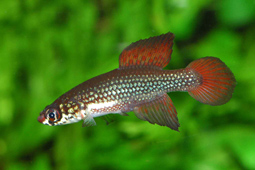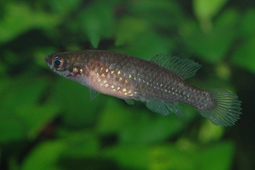History
Arthur Rachow did send the type material from this species to Regan after he (or somebody else) discovered the species in an aquarium import. Regan described the fish as Cynopoecilus melanotaenia. The name melanotaenia was taken from the greek word <melas or melaina> which refers to the black colors on the males sides, combined with <tainia> also greek whichs means band or line. In the years following the species was also placed in Cynolebias (Parenti) and later again back into Cynopoecilus.
The German Albert Mayer was the first to describe the reproduction of the species.
Nowadays Cynopoecilus is not the only member of the genus anymore. The total number of species is now (jan. 2007) settled to 5. Others are: Cynop. fulgens, intimus, multipapillatus and nigrovittatus.
Reproduction
Cynopoecilus is living more in the south of the continent in Uruguay and south Brasil and can stand also low temperatures, even below 12 C for a while and can stand also hot values as 28 C. They are not real divers and females drop there eggs also above the bottomlayer in many occasions. The fertilisation is probably internal as males can generate a sort of gonopodium, an tubelike constellation of the first rays of the anal fin.
It is advised to keep one male with more than one female because males can drive females to hard in smaller breedingtanks without much of shelter. In nature they live in soft and acid waters, not far from large waterbodies in stagnant shallow pools that occasionally, but not always, dry out.
Breeding this species is not to difficult if kept in the proper waterquality and fed mainly by live food like mosquito lavae and white worms. Eggs should have an incubation lag of 3 to 4 months and watered with cool water after being stored in damp peat.
After the first group of juveniles has hatched and removed into an other tank, repack the peat for another 4 weeks and water them again after that period. Often a large number of eggs do develop more slow for savety reasons. Growth is fast if life food is given daily. Maturity in 6 weeks. The assumed lifespan is 1,5 year, under cooler conditions possible longer.
This very intersting species is also called <The Fighting Gaucho> because the males can fight and flash, showing there most intense colors.
Variations
Map
Meristics
Max. size 4.0 cm.
Dorsal 17.5,
Anal 23.5,
D/A -2.0,
LL scale count (average)26.0
Pre- dorsal length to % SL – 57.0 %
Depth to % SL – 29.0 %
Literature


